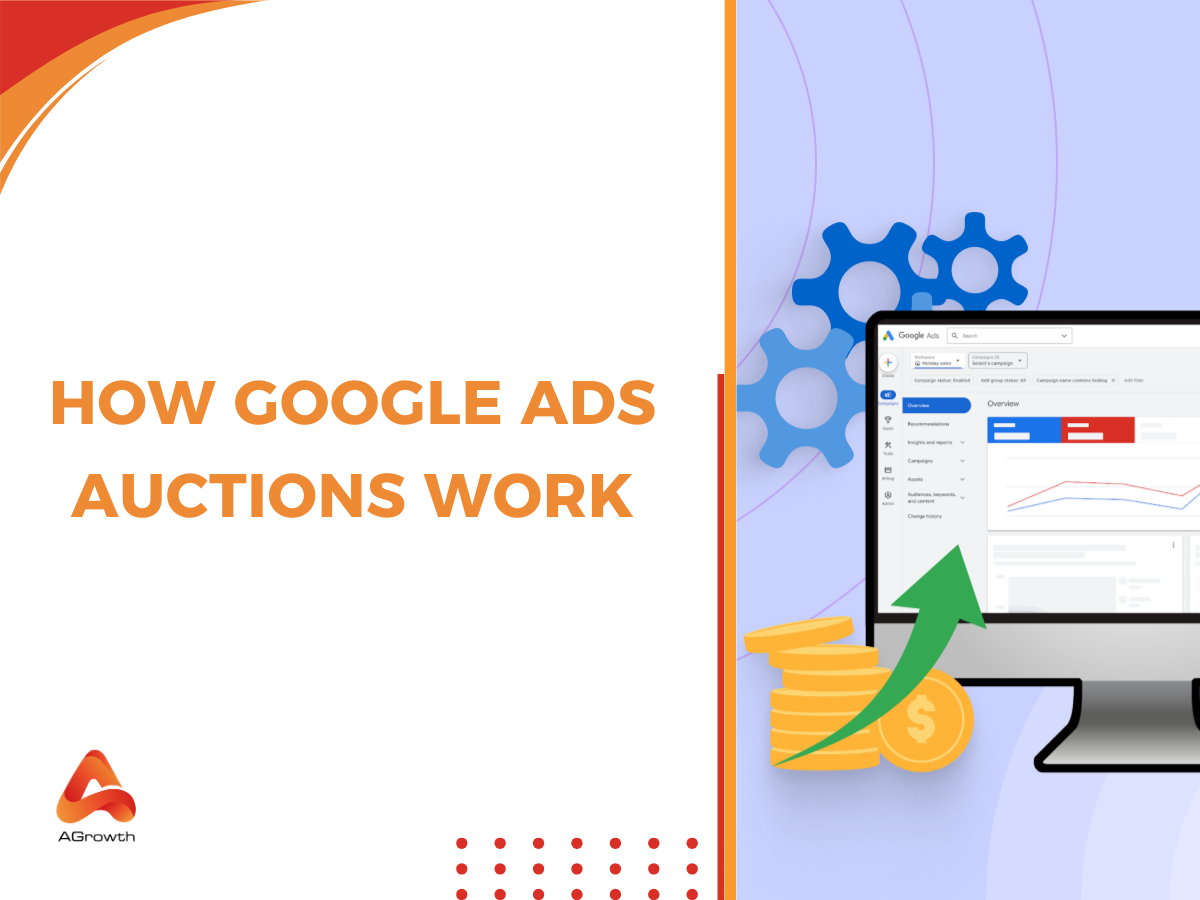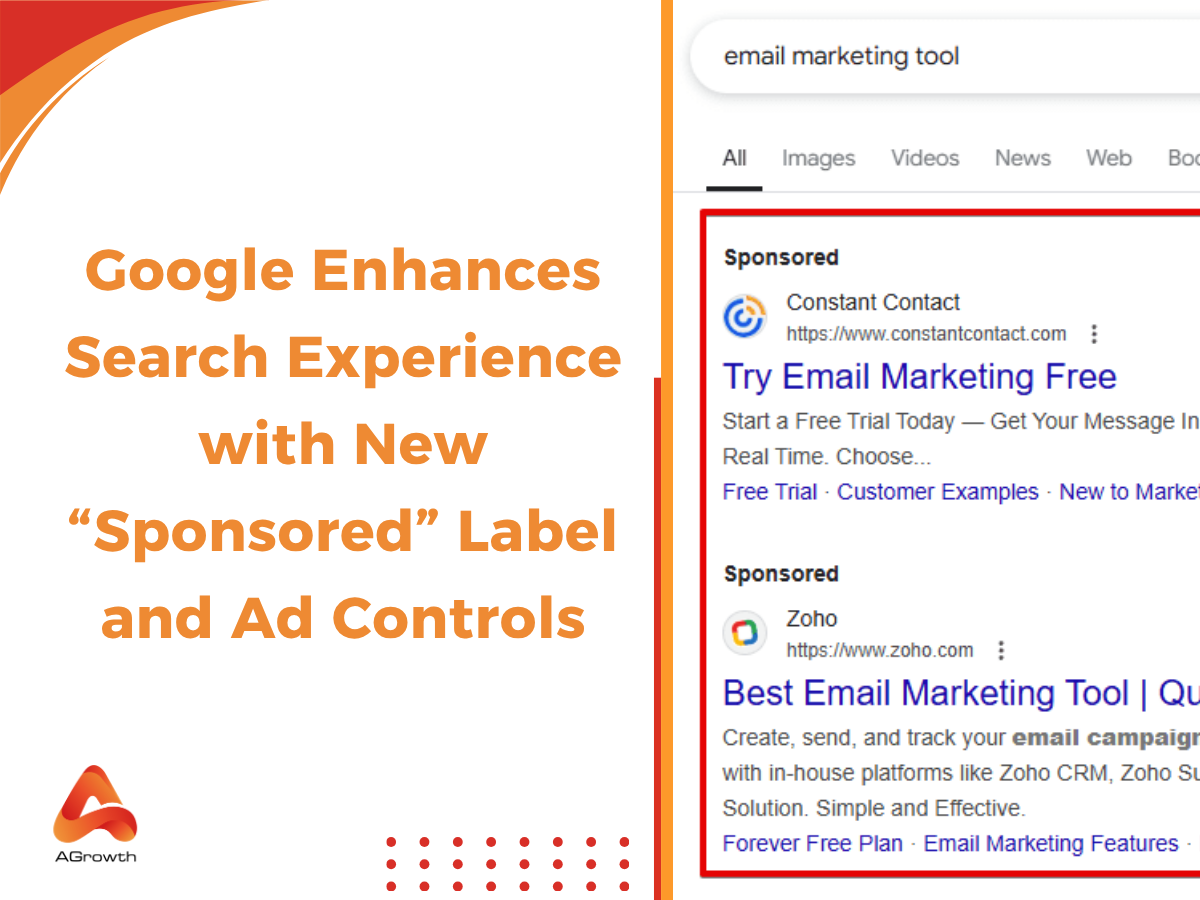
Table of Contents
How Google Ads Auctions Work: From Key Components to Winning Bidding Strategies
In competitive markets, every click can be the difference between a profitable campaign and wasted ad spend. For advertisers using Google Ads, the ad auction determines who gets visibility, where they appear, and how much they pay.
Understanding this process isn’t just a nice-to-have—it’s essential for optimizing budgets, maximizing ROI, and staying ahead of competitors who are bidding for the same audience.
In this guide, we’ll break down how Google Ads auctions work, the factors that influence results, and how you can leverage the system to win better positions without overspending.
What Is the Google Ads Auction?
The Google Ads auction is a real-time process that runs every time a user performs a search or visits a site in the Google Display Network. It decides which ads will be shown, in what order, and at what cost.
Unlike a traditional auction, where the highest bidder wins, Google’s system balances bid amounts with ad quality to ensure users see relevant, high-quality ads. This approach also incentivizes advertisers to create better campaigns rather than simply outspending competitors.
Every single search query triggers its auction, meaning your ad competes under slightly different conditions each time—depending on the competition, the user’s intent, and contextual signals like device type and location.

Key Components of the Google AdWords Auction System
Understanding how the Google Ads auction works requires knowing its key components. These elements interact in real time every time a user performs a search, determining which ads appear, where they appear, and how much each advertiser pays.
Keywords and Match Types
The auction process begins with advertisers selecting keywords that are relevant to their products or services. Each keyword can have different match types—broad match, phrase match, and exact match—that define how closely a user’s search query must match the keyword to trigger the ad.
-
Broad match maximizes reach but may include less relevant traffic.
-
Phrase match ensures the keyword phrase is present in the query.
-
Exact match offers the highest precision but limits exposure.
Search Query
When a user enters a search query, Google determines if it matches any advertiser keywords. Only matching keywords are eligible to enter the auction for that specific search.
Ad Rank
Ad Rank is a crucial score that determines both the position of your ad on the Search Engine Results Page (SERP) and whether it will show at all.
It is calculated using:
-
Bid amount (maximum CPC you are willing to pay)
-
Quality Score (relevance, CTR, landing page experience)
-
Ad extensions and formats (impact on performance)
-
Auction-time factors (user’s device, location, time of day, etc.)
Quality Score
Google’s Quality Score is a diagnostic tool that reflects the relevance and quality of your ads, keywords, and landing pages.
-
Higher Quality Scores can reduce CPC and improve ad positions.
-
Components include expected CTR, ad relevance, and landing page experience.
Bidding Strategy
The bidding approach—whether manual or automated—affects how aggressively your ad competes in the auction. Strategies like Target CPA or Target ROAS optimize for conversions or revenue rather than just clicks.
For those who want to explore more about Google Ads Automated bidding, read our post!
Ad Extensions and Formats
Ad extensions (such as sitelinks, callouts, and structured snippets) enhance your ads’ visibility and click-through rates. Google factors these into Ad Rank, meaning they can be the difference between your ad appearing above or below competitors.
Contextual Factors at Auction Time
Even with the same keyword, bid, and Google Ads Quality Score, your ad’s position can vary depending on:
-
The user’s device type (desktop, mobile, tablet)
-
The user’s location
-
The time and day of the search
-
Other competing ads and their bids at that exact moment
Why it matters for advertisers:
Mastering these components ensures you can design campaigns that balance cost, reach, and profitability. For experienced advertisers, small adjustments in Quality Score or bidding strategy can yield significant improvements in ROI.
Core Factors That Influence the Auction
Several variables determine your performance in each auction. While the mechanics may seem complex, they revolve around three primary elements.

1. Bid (Maximum CPC)
Your bid is the maximum amount you’re willing to pay for a click. However, you rarely pay your full bid—Google uses a version of the second-price auction model, meaning you pay just enough to beat the advertiser ranked directly below you.
That said, bidding too low can limit visibility, while bidding too high without optimizing quality can lead to poor ROI.
2. Quality Score
Quality Score is Google’s 1–10 rating of your ad relevance and user experience. It’s calculated using:
-
Expected Click-Through Rate (CTR): Likelihood your ad will be clicked.
-
Ad Relevance: How closely your ad matches the user’s intent and search terms.
-
Landing Page Experience: Content quality, loading speed, mobile friendliness, and alignment with the ad message.
A higher Quality Score reduces your actual CPC and can help you outrank competitors with higher bids but poorer ad quality.
3. Ad Rank
Google Ad Rank is the numerical value Google assigns to determine your ad’s position.
The formula can be summarized as:
Ad Rank = Bid × Quality Score + Contextual Factors
Additional factors include:
-
User’s location
-
Device type
-
Time of day
-
Search terms specificity
-
Ad formats and extensions used
Because Ad Rank directly influences both position and price, optimizing it is critical to winning auctions cost-effectively.
How Google Ads Auctions Work?
The Google Ads auction is the core mechanism determining when and where your ads appear on the Search Network. Every time a user searches on Google, an instant auction takes place in milliseconds to decide which ads are shown, in what order, and at what cost.
Understanding how this process works is essential for advertisers who want to maximize visibility while keeping costs under control.

1. The Trigger: User Search Query
The auction starts when someone enters a search term that matches keywords in advertisers’ campaigns. This matching process can occur through different keyword match types — broad, phrase, or exact — influencing how closely a search must align with your chosen keywords.
2. Identifying Eligible Ads
Google evaluates all ads that could potentially match the search query. To qualify, your ad must:
-
Target the correct location, language, and device type.
-
Have an active campaign and ad group with relevant keywords.
-
Comply with Google’s advertising policies.
If your ad doesn’t meet these criteria, it’s excluded from the auction before ranking decisions are made.
3. Calculating Ad Rank
Ad Rank determines both the position of your ad and whether it appears at all. It’s not just about who bids the highest — Ad Rank is calculated using multiple factors:
-
Your bid amount: The maximum you’re willing to pay per click.
-
Quality Score: A measure of ad relevance, expected click-through rate (CTR), and landing page experience.
-
Ad extensions and formats: The usefulness and appeal of additional features like sitelinks or call buttons.
-
Competitiveness of the auction: How many advertisers are competing for the same query.
-
User context: Factors like location, device, and search intent.
Even if your bid is lower than a competitor’s, a higher Quality Score can place your ad above theirs while paying less per click.
4. Determining Actual CPC
Winning the auction doesn’t mean paying your maximum bid. Instead, you pay just enough to beat the Ad Rank of the advertiser below you, adjusted by your Quality Score.
The formula is:

This ensures you only pay what’s necessary to maintain your position, not your full bid amount.
5. Ad Placement and Display
Once Ad Rank is determined, ads are placed in the available positions on the SERP (Search Engine Results Page). Premium spots above the organic results get the highest visibility, but they also face the most competition and potentially higher CPCs.
6. Auction Happens Every Time
Importantly, Google runs a new auction for every single search — meaning your ad’s position can change constantly depending on real-time competition, user intent, and your campaign settings.
Bidding Strategies in the Google Ads Auction
Choosing the right bidding strategy in Google Ads is not just about picking a number for your maximum bid—it’s about aligning your bidding approach with your overall campaign goals, competitive landscape, and budget efficiency. In the Google Ads auction, your bid interacts with factors like Quality Score, ad relevance, and expected impact of extensions, so having the right strategy can be the difference between a profitable campaign and wasted spend.
Below is a breakdown of key bidding strategies, when to use them, and how they impact auction outcomes.
Manual CPC (Cost-Per-Click) Bidding
Manual CPC gives you full control over the maximum cost-per-click you’re willing to pay for each keyword or ad group.
-
When to use: Best for advertisers with smaller, tightly monitored campaigns or when testing new keywords.
-
Pros: Precision control allows for granular adjustments based on performance.
-
Cons: Requires constant monitoring; can underperform if not optimized regularly.
Example: A B2B SaaS company bidding aggressively on high-intent keywords like “enterprise CRM software” to dominate top-of-page visibility.
Enhanced CPC (ECPC)
Enhanced CPC is a semi-automated bidding option that adjusts your manual bids in real time based on the likelihood of a conversion. Google may increase or decrease your bid depending on auction-time signals like device, location, and audience behavior.
-
When to use: When you want automation’s efficiency but still retain some control over base bids.
-
Pros: Improves conversion potential without fully handing over bidding to algorithms.
-
Cons: Still relies on historical data—performance may be limited if your account is new.
Target CPA (Cost Per Acquisition)
Target CPA bidding is fully automated, setting bids to get as many conversions as possible at your target acquisition cost.
-
When to use: For campaigns focused on lead generation or sales where the value of each conversion is relatively fixed.
-
Pros: Saves time; ensures cost efficiency at scale.
-
Cons: Requires stable historical conversion data; may limit impression share for competitive terms.
Example: An e-commerce brand setting a Target CPA of $25 for “custom t-shirt printing” campaigns.
Target ROAS (Return on Ad Spend)
Target ROAS focuses on maximizing revenue relative to your ad spend. Google sets bids to try and achieve your desired return.
-
When to use: For campaigns where the value of each conversion varies (e.g., retail with a broad product range).
-
Pros: Optimizes for profitability, not just volume.
-
Cons: Needs robust conversion tracking with revenue data.
Maximize Clicks
Maximize Clicks is a volume-oriented strategy that automatically sets bids to drive as many clicks as possible within your budget.
-
When to use: For awareness campaigns or when trying to increase traffic to a new landing page.
-
Pros: Easy to implement; good for driving top-of-funnel activity.
-
Cons: May sacrifice quality of clicks for quantity.
Maximize Conversions
Maximize Conversions automatically sets bids to get the most conversions for your budget.
-
When to use: Short-term promotions or when you want quick scaling without worrying about individual bid amounts.
-
Pros: Fast optimization; fully automated.
-
Cons: Can be costly if conversion quality isn’t monitored.
Finding the Right Google Ads Partner
For many businesses, succeeding in Google’s competitive auction environment requires more than just setting up ads — it demands precision strategy, deep market insights, and the right account resources. While some brands work with full-service agencies, others partner with specialized providers that give them the infrastructure to scale without limitations.
AGrowth stands out as a trusted provider for businesses seeking Google Ads agency accounts with unlimited spending capacity. By renting a high-trust account, companies can bypass many of the typical restrictions that slow down growth, such as low daily budgets or sudden ad disapprovals. This is especially valuable in competitive industries where speed and scale are critical.
A capable Google Ads partner — whether an agency or an account provider — should be able to:
-
Analyze Auction Insights to identify competitive advantages and benchmark your ad performance against industry rivals.
-
Develop bidding strategies that align with your specific revenue or lead generation goals.
-
Optimize Quality Score and Ad Rank to secure better ad placements at lower costs.
-
Maintain campaign stability by ensuring compliance and reducing the risk of account suspensions.









Your comment